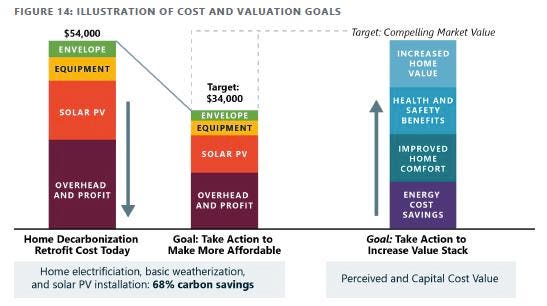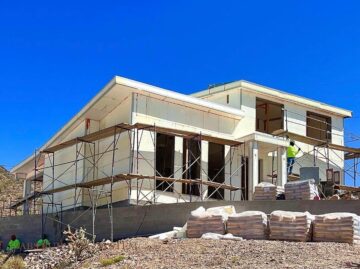
As one of many actions to reach a net zero energy economy by 2050, the U.S. is finding ways to minimize the impact of existing housing, which is difficult because as a subset of the country’s overall decarbonization efforts, residential buildings have one of the most diverse existing landscapes.
Variety is the spice of life, but in the case of retrofit solutions to decarbonize housing, it’s not so charming. It demands individual attention by energy auditors and contractors and means that there can be no streamlined pathway to decarbonization with a good user experience for the pros that are required to do the work.
“There are more than 100,000 individual contracting companies in the U.S.,” said Sage Briscoe, the director of federal policy at Rewiring America, a nonprofit organization advocating for clean energy. “Trying to get them up to speed is a big task.”
Grant Farnsworth is the president at market research firm The Farnsworth Group and he agrees that the sophistication and size of contractors is so fragmented that expecting the industry to work in lock step in a substantial manner is a fantasy.
“Plus, like we have seen in other areas, remodelers are laggards when it comes to sustainability,” he said. “They typically aren’t proactively seeking differentiation in the market. They do it when it’s necessary, like when it is driven by compliance or insurance.”
Customer Engagement
Pros rated lack of consumer demand as the biggest barrier to doing retrofit projects.
LBNL
Typically, consumer demand will pull through and catalyze engagement from the industry, but some housing experts are noticing a trend of softening consumer demand.
For instance, the Lawrence Berkeley National Lab’s (LBNL) deep energy retrofit survey of 1,700 projects identified customer demand as one of the biggest challenges, and suggests that in order to drive demand, solutions will need to be readily available, affordable, easy to finance, reliable, safe, and resilient.
Houzz studies find that the most frequently cited appeal for making sustainable choices is long term cost effectiveness, outpacing non-financial reasons like being environmental stewards. In the company’s studies, only 7% of consumers list environmentally friendly as a consideration for a renovation project, while the top three considerations are ‘price within budget,’ ‘quality,’ and ‘design.’
Contractor marketplace Thumbtack’s survey of 1,000 Americans about home improvement plans showed that 32% consider sustainable, energy efficient home projects too expensive and 31% feel unsure about where to begin.
While The Farnsworth Group study reports that the value and benefits for the customer is one of a contractor’s top priorities – second only to cost. That value and benefit is wrapped up in the costs and the energy savings that would be passed along to the homeowner.
According to the Appraisal Journal, home value increases $20 for every $1 reduction in annual utility bills. So, a solar energy system that saves $200 per year would also add $4,000 to the value of a home.
But that finding hasn’t stayed consistent, says Amanda Pendleton, who directs home trends research for Zillow. The real estate firm found solar panels did not command a premium in 2022, and suggests that is due to the exceptionally tight and expensive housing market.
While demand may be lagging, there are examples of programs that are done right and that gain rapid adoption. For instance, the TECH clean California program offers incentives, pilot activities, technical assistance, and training to get California to its goal of being carbon neutral by 2045. The program has been well received, even getting much more interest than anticipated and rapid participation growth.
Lack of Labor
While the construction industry is short millions of laborers, the electrification and retrofit of … [+]
Rewiring America
The construction industry currently has more than two million open positions according to the National Association of Home Builders. While those positions won’t all contribute to decarbonization efforts, the magnitude of the issue is putting a lot of strain on net zero adoption efforts.
In addition, many of the new decarbonization solutions require a specific skill set and contractors typically develop fairly niche expertise. Fortunately, she sees that manufacturers are stepping up with information to help contractors and consumers understand significant product details, how it will impact energy savings, and how to install it.
According to Farnsworth, some contractors are passing on opportunities to install more sustainable products if they require a specialist or if the product is more expensive. He also reports that if the contractor has to buy more expensive products, they may not change already established practices.
In addition, changing building codes may require a specialist’s involvement, making the contractor avoid the product or stick with current practices because it means too much impact to their business.
Farnsworth sees that a lot is landing on the manufacturers to avoid putting any burden on the pro.
“They have to deliver product at the same price point, with the same brand, the same installation, and be compliant without changing anything,” he said.
The LBNL survey also cites a lack of a reliable, trained home performance workforce. Plus, online recruiting platform Handshake reported that young people applying for jobs like plumbing, building and electrical work, dropped by 49% in 2022 from 2020.
Analyzing The Costs
Cost is always a challenge and a couple recent trends make understanding the dollars critical.
In a recent presentation, Todd Tomalak, a principal at housing market research group Zonda, said there has been an overall reversal in mobility for homeowners—where moves were happening on average every 10 years, it’s now every 20 years or more. He also reported that 20% of people’s net worth is equity in their home.
So, an investment in the home is not only more likely, but it would have a more profound impact on ongoing expenses, savings and investments rather than considering for resale value.
A U.S. Department of Energy’s 2021 study showed that to achieve at least 50% carbon reductions in the average home, the project would cost about $55,000, which is a daunting figure for many households when the average home improvement investment today sits at about $22,000.
LBNL also assessed project cost data from its survey to understand where project money was spent, then to identify ways to achieve greater energy reductions at lower costs.
The lowest cost ways to arrive at a 50% energy savings depend on including photovoltaics to offset energy as well as envelope and appliance upgrades. However, the report says it is possible to have more than 70% energy savings with readily available off the shelf insulation, lighting, appliance, domestic hot water and heating and air conditioning solutions.
Plus, while retrofits cost a lot of money, energy in the U.S. is fairly inexpensive. The government is trying to provide incentives to balance the costs, such as rebates and tax credits, which rank as the most effective way to increase customer demand for energy retrofit projects.
A survey by LBNL looked at the deep energy retrofit market drivers, opportunities and challenges to broaden the adoption of deep energy retrofits. For homeowners, cost is the most important factor for digging into an energy retrofit project, but they are also motivated by improved comfort, energy savings, sustainability, or carbon reduction.
The Pacific Northwest National Laboratory (PNNL) has embarked in some consumer research to understand the homeowners’ motivations and help spur engagement. Chrissi Antonopoulos, senior analyst at the lab says that the best motivator is rebates even if they are small.
“It is about getting a deal, which makes them much more likely to participate, but from an economic perspective, people struggle with rebates because they have to shell out money up front and wait to be reimbursed,” Antonopoulos said.
Preliminary results from the lab’s study shows that the most promising technologies for adoption are heat pumps, smart controls, and real-time monitoring and diagnostics. Homeowners also want to be able to spread out the costs by only replacing equipment as it needs to be replaced.
A fairly large opportunity exists for contractors to shrink margins on these types of projects according to LBNL’s Challenges and Opportunities to Home Decarbonization report from June 2022 authored by the organization’s decarbonization leaders Iain Walker, Brennan Less and Nuria Casquero-Modrego. The report shows that across the construction industry, gross margins were higher than industry averages for home performance contractors, sitting at 47% on average. This is much higher than the 33% gross margin for standard residential remodeling, and the typical 10 to 26% gross margin for new construction.
This gap in profit margins spells out an opportunity. If energy upgrade businesses were to reduce gross margins to the level of standard remodeling, overhead and profit costs could be reduced from 47 to 33%, representing a 14% reduction in total project costs. Although the potential for reduced costs is clear, the way to get there is not.
One possibility would be to reduce soft costs that are unique to a project, such as diagnostic testing or energy program administration. Another path that seems increasingly unrealistic due to the current labor market would be to increase market demand and the availability of skilled trades. This approach would drive efficiencies and reduce overhead for these types of projects.
The survey showed that among soft costs, while not common to all projects, professional services from architects could reach up to $10,000 per project. These costs could be reduced with more standardized approaches and guidance for contractors.
Other large costs fall into the categories of home inspections or energy audits and HVAC load sizing, travel and customer management, and building permit costs.
The report also suggested outsourcing customer acquisitions as a prime opportunity to reduce soft costs. Customer acquisition typically costs up to $2,500 per project, which can be reduced to $700 per project by using a skilled marketing group and use of best practices.
Other cost reductions would include automating diagnostic testing and commissioning or using remote approaches for audits to reduce costs by up to 60% per project.
Getting Educated
Knowledge is power and it will be one major catalyst to powering adoption of home energy improvements, but where and how that knowledge is delivered makes a big difference. For example, The Farnsworth Group survey reported that contractors use online sources and trade media to learn about policy change and, maybe more importantly, that they don’t trust government agencies.
“Who trusts the government for anything?” he said. “The majority of pros are gravitating toward industry media. The more you get nuanced in how fresh and new policy information is needed, the more trade media is used. They use social media differently.”
Most contractors have only a surface knowledge of the Inflation Reduction Act (IRA) and very few focus their company’s brand and messaging on energy retrofits.
“The federal government, while they are authoritative, aren’t the best in giving contractors tools,” Briscoe said. “That’s what Rewiring America has set out to do – eliminate the friction in accessing IRA benefits.”
Farnsworth sees the opportunity for government agencies to leverage private partnerships to act as a conduit of information to the mediums that are more trusted and used.
“We cannot rely on government to be the educator – they have to push the content to other sources,” he said.
Again, Farnsworth believes there is a lot of pressure being put on manufacturers to be the source of information, even while product and material availability are reported as the biggest challenge to projects today.
“Manufacturers and service providers have an opportunity to be a knowledge source,” Farnsworth said. “They have responsibility and opportunity as it relates to specs and products as it relates to the policies.”
Technology Coming Into Play
While technology adoption isn’t typically a strong point for builders and contractors, it promises to play an important role in all aspects of the energy transition – from shopping for products to education, from product installation to energy monitoring, and from rebate processing to project management.
New startups and solutions are popping up on a weekly basis to address these various parts of the process, again putting slower moving bureaucracy behind and forcing contractors to rely on information from manufacturers, service providers, trade media and peers.
McKinsey reports that investments in climate tech tripled from 2020 to 2022 compared to previous years, adding up to more than $130 trillion pledged by stakeholders for the transition to net zero energy, water and carbon. The firm estimates $150 trillion will be needed over the next three decades to meet climate goals, and only about 35% of the necessary technology has been invented.
“Contractors and their customers have evolving preferences, so stakeholders have to invest in technology,” Bill Rossiter, the CEO and principal at brand agency Interrupt. “You have to nurture conversations, so you don’t miss out on the ability to give the customer information that they need at a specific point in time. You have to build knowledge on your customers, and always look at and update it.”
He adds that the space is becoming much more competitive and if industry stakeholders focus on building brands and not building bonds, the decision will come down to price because that’s the only decision point that is black and white. As discussed, for contractors that price equation is immediately a factor when they have to think about changing anything at all.
One of the technologies recently launched by the U.S. Department of Energy’s Advanced Building Construction team helps consumers and contractors evaluate the necessary upgrades for a property based on its age and climate location. The tool gives recommendations based on 12 simple inputs and directs the user to a more precise assembly of products that a contractor can use to improve their home’s performance.
Arriving at the country’s decarbonization goals is going to take dedication, passion, commitment, better understanding, technology, and most of all, more collaboration. This won’t happen all at once, and will be messy, but it will certainly be worth it as probably the largest business opportunity for all company’s involved in remodeling and renovation today.
- SEO Powered Content & PR Distribution. Get Amplified Today.
- PlatoData.Network Vertical Generative Ai. Empower Yourself. Access Here.
- PlatoAiStream. Web3 Intelligence. Knowledge Amplified. Access Here.
- PlatoESG. Carbon, CleanTech, Energy, Environment, Solar, Waste Management. Access Here.
- PlatoHealth. Biotech and Clinical Trials Intelligence. Access Here.
- Source: https://www.forbes.com/sites/jennifercastenson/2023/10/25/five-missing-pieces-to-decarbonizing-todays-housing-stock/
- :has
- :is
- :not
- :where
- $UP
- 000
- 1
- 10
- 100
- 12
- 13
- 20
- 20 years
- 2020
- 2021
- 2022
- 2050
- 35%
- 500
- 700
- a
- ability
- Able
- About
- accessing
- According
- Achieve
- acquisition
- acquisitions
- across
- Act
- actions
- activities
- add
- adding
- addition
- address
- Adds
- administration
- Adoption
- advanced
- advocating
- affordable
- again
- age
- agencies
- AIR
- Air Conditioning
- All
- along
- already
- also
- Although
- always
- america
- Americans
- among
- an
- analyst
- and
- annual
- Another
- Anticipated
- Antonopoulos
- any
- anything
- appeal
- Applying
- approach
- approaches
- architects
- ARE
- areas
- AS
- aspects
- Assembly
- assessed
- Assistance
- Association
- At
- attention
- auditors
- audits
- authored
- automating
- availability
- available
- average
- avoid
- Balance
- barrier
- barriers
- based
- basis
- BE
- because
- becoming
- been
- begin
- behind
- being
- believes
- benefit
- benefits
- Berkeley
- BEST
- best practices
- Better
- Big
- Biggest
- Bill
- Bills
- Black
- Bonds
- brand
- brands
- broaden
- budget
- build
- builders
- Building
- buildings
- burden
- bureaucracy
- business
- businesses
- but
- buy
- by
- california
- CAN
- cannot
- carbon
- Carbon Reduction
- case
- Catalyst
- catalyze
- categories
- ceo
- certainly
- challenge
- challenges
- change
- changing
- choices
- cited
- clean energy
- clear
- Climate
- Codes
- collaboration
- COM
- come
- comes
- comfort
- coming
- commitment
- Common
- Companies
- Company’s
- compared
- competitive
- compliance
- compliant
- Consider
- consideration
- considerations
- considering
- consistent
- construction
- consumer
- Consumers
- content
- contracting
- Contractor
- contractors
- contribute
- controls
- conversations
- Cost
- Costs
- could
- country’s
- Couple
- create
- Credits
- critical
- Current
- Currently
- customer
- customer information
- Customers
- data
- deal
- decades
- decarbonization
- decarbonize
- decision
- dedication
- deep
- deliver
- delivered
- Demand
- demands
- Department
- details
- develop
- diagnostic
- Diagnostics
- DID
- difference
- difficult
- Director
- directs
- discussed
- diverse
- do
- doing
- dollars
- Domestic
- done
- Dont
- down
- drive
- driven
- drivers
- dropped
- due
- easy
- Economic
- economy
- Education
- Effective
- effectiveness
- efficiencies
- efficient
- efforts
- eliminate
- embarked
- energy
- engagement
- environmental
- environmentally
- environmentally friendly
- equipment
- equity
- established
- estate
- estimates
- evaluate
- Even
- Every
- evolving
- example
- examples
- exceptionally
- existing
- exists
- Expand
- expandable
- expecting
- expenses
- expensive
- experience
- expertise
- experts
- factor
- fairly
- Fall
- FANTASY
- Federal
- Federal government
- feel
- few
- Figure
- fill
- finance
- Find
- finding
- Firm
- five
- Focus
- For
- Forbes
- forcing
- Fortunately
- found
- fragmented
- frequently
- fresh
- friction
- friendly
- from
- front
- Gain
- gap
- get
- getting
- Give
- gives
- Giving
- goal
- Goals
- going
- good
- Government
- government agencies
- graphic
- greater
- gross
- Group
- Growth
- guidance
- happen
- Happening
- Have
- he
- help
- helps
- higher
- Home
- Homes
- HOT
- households
- housing
- housing market
- How
- How To
- However
- HTTPS
- hvac
- identified
- identify
- if
- immediately
- Impact
- important
- importantly
- improve
- improved
- improvement
- improvements
- in
- In other
- Incentives
- include
- Including
- Increase
- Increases
- increasingly
- individual
- industry
- inexpensive
- inflation
- information
- inputs
- install
- installation
- instance
- insurance
- interest
- into
- Invented
- Invest
- investment
- Investments
- involved
- involvement
- IRA
- issue
- IT
- ITS
- Jobs
- journal
- jpg
- june
- knowledge
- lab
- labor
- labor market
- laboratory
- Lack
- laggards
- lagging
- landing
- large
- largest
- launched
- lawrence
- leaders
- LEARN
- least
- less
- Level
- Leverage
- Life
- Lighting
- like
- likely
- List
- load
- location
- Long
- Look
- looked
- Lot
- lower
- lowest
- major
- Majority
- make
- MAKES
- Making
- management
- manner
- Manufacturers
- many
- Margin
- margins
- Market
- market research
- Marketing
- marketplace
- material
- May..
- maybe
- means
- Media
- Meet
- messaging
- million
- millions
- minimize
- miss
- missing
- mobility
- money
- monitoring
- more
- most
- motivated
- motivations
- moves
- moving
- much
- National
- necessary
- Need
- needed
- needs
- net
- Neutral
- New
- New Construction
- new policy
- next
- niche
- no
- Nonprofit
- now
- nurture
- of
- off
- Offers
- offset
- on
- once
- ONE
- ongoing
- online
- only
- open
- opportunities
- Opportunity
- or
- order
- organization
- Other
- out
- Outsourcing
- over
- overall
- Pacific
- panels
- participate
- participation
- partnerships
- parts
- passed
- Passing
- passion
- path
- pathway
- peers
- People
- people’s
- per
- perform
- performance
- perspective
- pieces
- pilot
- plans
- platform
- plato
- Plato Data Intelligence
- PlatoData
- Play
- Plumbing
- plus
- Point
- policies
- policy
- position
- positions
- possibility
- possible
- potential
- power
- Powering
- practices
- precise
- preferences
- Premium
- presentation
- president
- pressure
- previous
- price
- Prime
- Principal
- private
- Pro
- probably
- process
- processing
- Product
- Products
- professional
- Profit
- profound
- Program
- Programs
- project
- project management
- projects
- promises
- promising
- property
- PROS
- provide
- providers
- pumps
- Push
- put
- Putting
- rank
- rapid
- rated
- rather
- reach
- readily
- real
- real estate
- real-time
- reasons
- Rebate
- rebates
- received
- recent
- recently
- recommendations
- recruiting
- reduce
- Reduced
- reduction
- reductions
- relates
- relative
- reliable
- rely
- remote
- replaced
- report
- Reported
- Reports
- representing
- require
- required
- research
- research group
- residential
- resilient
- responsibility
- Results
- Reversal
- right
- Role
- s
- safe
- Said
- same
- Savings
- says
- Second
- seeking
- seems
- seen
- sees
- senior
- service
- service providers
- Services
- set
- she
- Shelf
- Shell
- Shopping
- Short
- showed
- Shows
- significant
- Simple
- sits
- Sitting
- Size
- skill
- skilled
- small
- smart
- So
- Social
- social media
- Soft
- solar
- solar energy
- solar panels
- Solutions
- some
- sophistication
- Source
- Sources
- Space
- specialist
- specific
- specs
- speed
- spent
- spice
- spread
- stakeholders
- standard
- standardized
- Startups
- stayed
- Step
- stepping
- Stick
- stock
- streamlined
- strong
- Struggle
- studies
- Study
- substantial
- such
- Suggests
- Surface
- Survey
- Sustainability
- sustainable
- system
- Take
- Task
- tax
- team
- tech
- Technical
- Technologies
- Technology
- term
- Testing
- than
- that
- The
- The Source
- their
- Them
- then
- There.
- These
- they
- Think
- this
- those
- three
- Through
- time
- to
- today
- today’s
- todd
- too
- tool
- tools
- top
- Total
- toward
- trade
- trades
- trained
- Training
- transition
- travel
- Trend
- Trends
- Trillion
- Trust
- trusted
- Trusts
- trying
- two
- types
- typical
- typically
- u.s.
- understand
- understanding
- unique
- Update
- upgrade
- upgrades
- use
- used
- User
- User Experience
- using
- utility
- value
- various
- very
- wait
- walker
- want
- was
- Water
- Way..
- ways
- we
- weekly
- WELL
- were
- What
- when
- which
- while
- white
- WHO
- will
- with
- within
- without
- Work
- Workforce
- worth
- would
- Wrapped
- year
- years
- you
- young
- Your
- zephyrnet
- zero
- Zillow
- zonda












